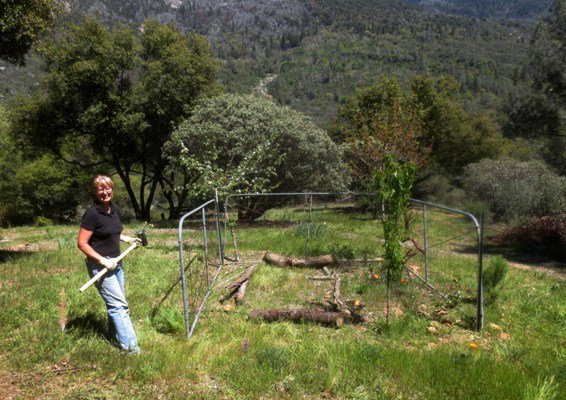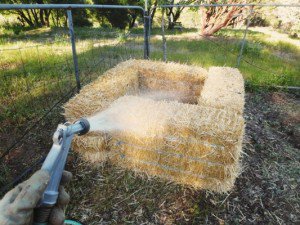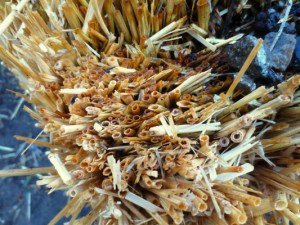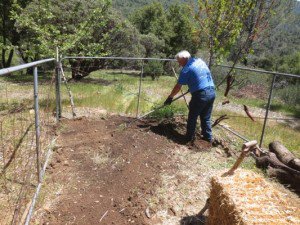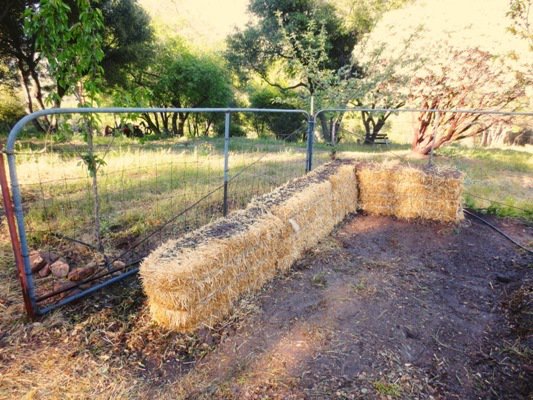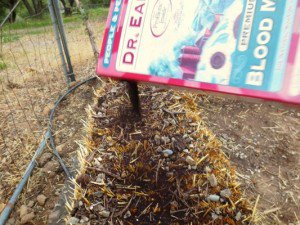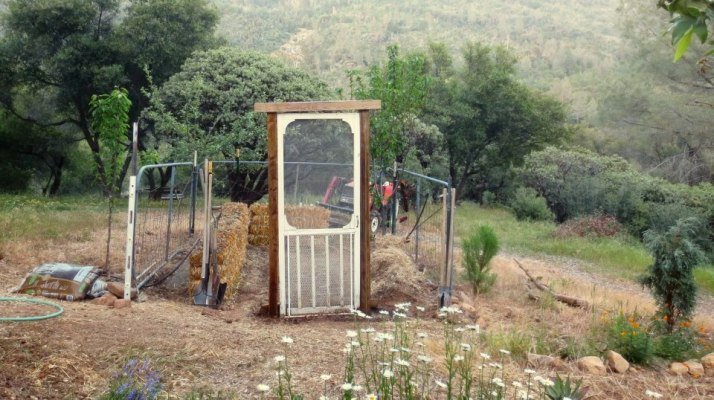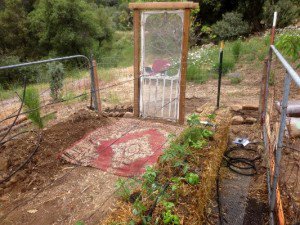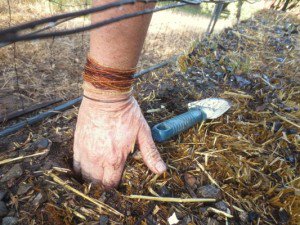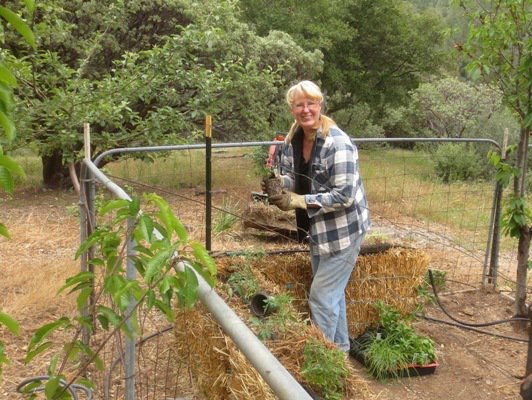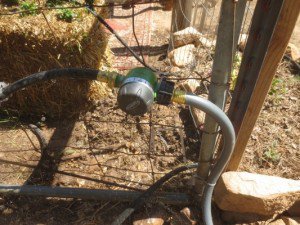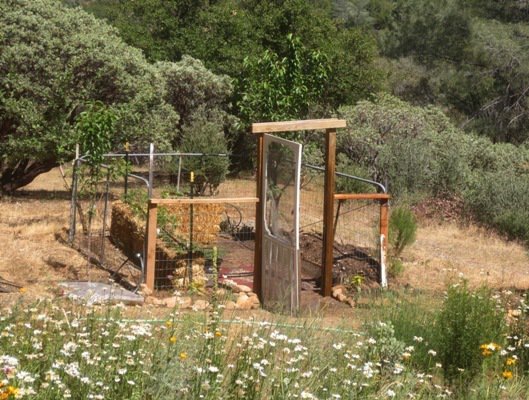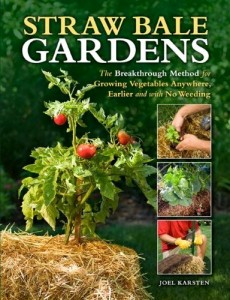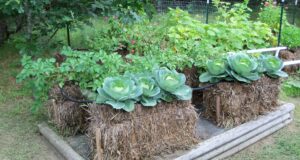Recently I decided to try the technique called straw bale gardening, after an online chat with the author, Joel Karsten, who wrote the book, Straw Bale Gardens. My garden is on a mountainside in Central California. See the steps I took in this experiment!
Ranch Gate Garden-
I had plans for fencing in a garden finally, so the deer would be discouraged. Our property is right next to the National Forest and deer cross through daily. I had found three old gates on our property and we staked them together first on this sloped piece of ground.
Setting up the bales
I timed my start date for four weeks from the day I wanted to plant, first week of May. The straw bales need that long to be ready. At first, I wanted to set the bales on their flat sides, like I had in my experimental bale at the nursery. Then I learned that you needed to set then cut side up so water runs through the bale through the ‘drinking straw’ straws. The nylon strings go around the sides.
We settled on three in a row and one crosswise like an “L”. We had to level the sloped ground here just so the bales would stand up right. I knew from the experimental one, that the bale would eventually compost down and fall apart, so ‘T’ stakes at either end would be needed.
Conditioning the bales
The bales need to be watered for 21 days at least. You also need to add nitrogen, as in a 10-10-10 fertilizer, or an organic option like blood meal that I used. This process starts the bales composting and becoming soft and workable. The nitrogen acts to combine with the decomposing straw to make a complete soil for the plants to grow in. While I waited and watered each day, I worked
Adding a bit of quirkiness
Next comes the Flea Market part. We needed a fourth side and I have a stack of old doors to use somehow, so I took this old screen door and we cobbled together the enclosure. The ground is so sloped that the door frame is the only level thing about the enclosure.I planned little flower beds on either side. It looks pretty bare at this point and someone even said ‘ugly,’ but I have a vision! I’ll get the practical part done, then decorate!
Adding a Trellis
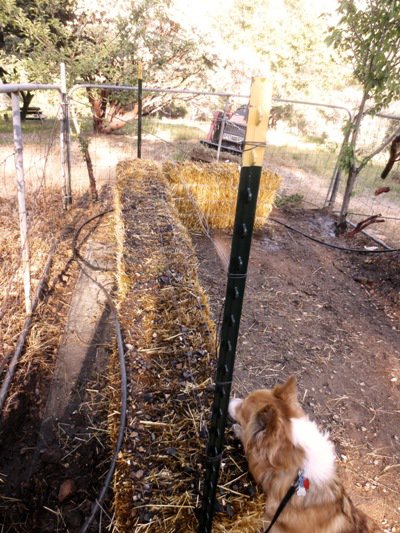
Trellis strung and soaker hose pinned down. Maggie is attracted (yucky!) by the blood meal sprinkled on top.
Next, we staked the ends of the bales to hold them together and I strung 16 gauge wire to act as a trellis. I laid out a soaker hose for watering and added a timer. I have no idea yet how much water will be needed as the bale hold moisture so well.
Now, after two weeks the bale was becoming nice, soft and sponge-like.
Planting time!
In the Straw Bales:
Cuostralee tomato
Italian Heirloom tomato
Red Zebra tomato
San Marzano tomato, a Roma.
Sweet peppers ‘Marconi’, sweet with a thin skin
Anaheim peppers
Fresno pepper
Tomatillo ‘Purple de Milpa’
Tomatillo ‘Toma Verde’ (you need two for fruit)
Bunching Onions ‘Red Baron’
Italian sweet basil
Mesclun
Cucumber ‘Diva’
Strawberries ‘Fresca’
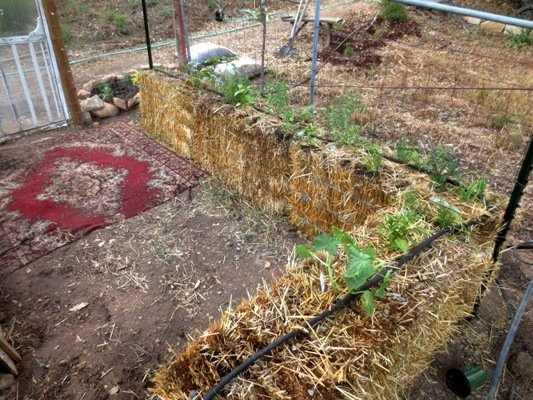
All planted for now, but will add lettuce in the shade of the cherry tree and “straw”berries! Notice the ‘fancy’ carpet…
Watering
I set up the timer for the soaker hose and it waters the two little planting beds on either side of the gate as well as the mound, the Hugelkultur. Hugelkultur? (More on that later, but it’s another gardening technique,…gardening in a mound or hill.) I tried it for 10 minutes and directed the water here and there around the garden, so things would drain well.
About the Book
Straw Bale Gardens: an imaginative way to upcycle straw bales and grow all the vegetables you need,…easily!
Flea Market gardeners love to repurpose things and use ordinary items for creative projects. This type of creative inspiration hit Joel Karsten after seeing hay and straw bales grow sprouts as they decomposed on the farm. He also found himself with a yard full of heavy clay and was disappointed that he’d have to replace all his soil to grow a garden. That’s when he remembered the straw bales of his youth, growing healthy thistle weeds!
Joel then tried growing vegetable plants in the straw bales purposely and it worked! After some experimentation, he found easy techniques for using straw bales as a growing medium for tomatoes, squash, beans and lettuce to name a few of the veggies that can be grown successfully this way. What I like best is the way bales can be laid out in a neat formations, use less soil,…way less… and best of all, are raised beds,..up off the ground.
Joel’s experiment led to a book and a website , Straw Bale Gardens and he has an impressive speaking schedule explaining his easy, fun and productive gardening method. Would you like to try this method of vegetable gardening? I would!

